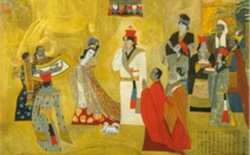Balkh & Ancient Tibet
The Tibetan Empire existed during the 7th and 9th centuries A.D., and ruled roughly the area of Tibetan Plateau.The historic name for the Tibetan Empire is different from Tibet's present name."This first mention of the name Bod, the usual name for Tibet in the later Tibetan historical sources, is significant in that it is used to refer to a conquered region....
Tsetang, Tibet’s third largest city, is the mythical birthplace of the Tibetan people. According to legend a monkey mediating in a cave was seduced by a female demon who had refused to wed another monster. She married the monkey and produced six children who grew up to form the six major tribes of Tibet. Another myth describes how the first Tibetan king descended to earth from heaven on a sky rope. These myth are believed to have their origin in the ancient Bon religion.
"New ideas that came into the empire as a result of its expansion, helped to create stresses and power blocs that were often in competition with the ruler at the center of the empire. Thus, for example, adherents of the Bön religion and the supporters of the ancient noble families gradually came to find themselves in competition with the recently-introduced Buddhism.
Songtsän Gampo (Srong-brtsan Sgam-po) (born ca. 604, died 650) was the first great emperor who expanded Tibet's power beyond Lhasa and the Yarlung Valley, and is traditionally credited with introducing Buddhism to Tibet.
The Chinese Princess Wencheng (Tibetan: Mung-chang Kung-co) departed China in 640 to marry Songtsän Gampo's son. She arrived a year later. This is traditionally credited with being the first time that Buddhism came to Tibet, but it is very unlikely Buddhism extended beyond foreigners at the court.....Songtsän Gampo’s sister Sämakar (Sad-mar-kar) was sent to marry Lig-myi-rhya, the king of Zhangzhung in what is now Western Tibet. However, when the king refused to consummate the marriage, she then helped her brother to defeat Lig myi-rhya and incorporate Zhangzhung into the Tibetan Empire. In 645, Songtsän Gampo overran the kingdom of Zhangzhung.
Between 665-670 Khotan was defeated by the Tibetans, and a long string of conflicts ensued with the Chinese Tang Dynasty. In the spring of 670, Tibet attacked the remaining Chinese territories in the western Tarim Basin. With troops from Khotan they conquered Aksu, upon which the Chinese abandoned the region, ending two decades of Chinese control. They thus gained control over all of the Chinese Four Garrisons of Anxi in the Tarim Basin in 670 and held them until 692, when the Chinese finally managed to regain these territories.
By 750 the Tibetans had lost almost all of their central Asian possessions to the Chinese. In 753, even the kingdom of "Little Balur" (modern Gilgit) was captured by the Chinese. However, after Gao Xianzhi's defeat by the Caliphate and Qarluqs at the Battle of Talas (751), Chinese influence decreased rapidly and Tibetan influence began to increase again. Tibet conquered large sections of northern India during this time.
the Uyghurs, nominal allies of the Tang emperors, continued to make difficulties along Tibet's Northern border. Toward the end of this king's reign Uyghur victories in the North caused the Tibetans to lose a number of their allies in the Southeast.[36]
Recent historical research indicates the presence of Christianity in as early as the sixth and seventh centuries, a period when the Hephthalites had extensive links with the Tibetans. A strong presence existed by the eighth century when Patriarch Timothy I (727-823) in 782 calls the Tibetans one of the more significant communities of the eastern church and wrote of the need to appoint another bishop in ca. 794.
In 801, Tibetans were active as far west as Balkh, Samarkand and Kabul. Caliphate forces began to gain the upper hand, and the Tibetan governor of Kabul submitted to the Caliphate and became a Muslim about 812 or 815. The Caliphate then struck east from Kashmir, but were held off by the Tibetans. In the meantime, the Uyghur Khaganate attacked Tibet from the northeast. Strife between the Uyghurs and Tibetans continued for some time
This research explores my understanding that historically and geographically, the 'legendary' Kingdom of Shambhala was located in the region of Shamis en Balkh (Sham-i-Bala, Bactra, Zariasta)....the great ancient city in Bactria (a region possibly known as Tagzig, Oddiyana, Olmo Lungring) and the great rich and fertile region surrounded by the Pamir and Hindu Kush Mountains.
Tritsu Detsen (Khri gtsug lde brtsan), best known as Ralpacan, is important to Tibetan Buddhists as one of the three Dharma Kings who brought Buddhism to Tibet. Tibetans attacked Uyghur territory in 816 and were in turn attacked in 821. After successful Tibetan raids into Chinese territory, Buddhists in both countries sought mediation. Ralpacan was apparently murdered by two pro-Bön ministers who then placed his anti-Buddhist brother, Langdarma, on the throne.
The reign of Langdarma (Glang dar ma), regal title Tri Uidumtsaen (Khri 'U'i dum brtsan), was plagued by external troubles. The Uyghur state to the north collapsed under pressure from the Kyrgyz in 840, and many displaced people fled to Tibet. Langdarma himself was assassinated, apparently by a Buddhist hermit, in 842....The civil war that arose over Langdarma's successor led to the collapse of the Tibetan Empire. The period that followed, known traditionally as the Era of Fragmentation, was dominated by rebellions against the remnants of imperial Tibet and the rise of regional warlords.
"With the consolidation of the Tibetan empire in the seventh century AD under the Yarlung kings there was increasing contact between Tibet, India and China, establishing a lasting pattern of cultural contact and exchange. Under Srong brTsan sGam Po (around 618-41) scholars were sent to India to develop a system of writing for the Tibetan language and, as part of treaty negotiations with the Chinese, the emperor married a Tang dynasty (618-907) princess.The Yarlung empire disintegrated in the mid-ninth century. Buddhism, dependant on royal support, suffered set-backs, but from the late-tenth century efforts were made to re-establish links with Indian centres of knowledge. The arrival of the Indian-born master Atisha in 1042 is generally regarded as the culmination of the ‘second propagation’ of Buddhism in Tibet.


